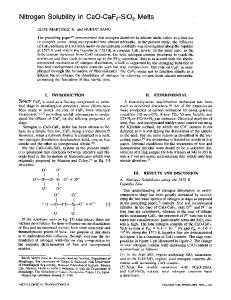The solubility of Fe 2 O 3 in cryolite-alumina melts
- PDF / 167,235 Bytes
- 3 Pages / 612 x 792 pts (letter) Page_size
- 103 Downloads / 271 Views
lity of Fe2O3 in CryoliteAlumina Melts QUOC BAO DIEP, ERNEST W. DEWING, and ˚ SMUND STERTEN A Fe2O3 is a constituent of some materials that have been proposed for use as nonconsumable anodes in the production of aluminum by the electrolysis of cryolite-alumina
QUOC BAO DIEP is with Nammo Raufoss AS, Raufoss, Norway. ERNEST W. DEWING, Kingston, ON, Canada K7M 5T8, is retired. ˚ SMUND STERTEN, former Professor of Electrochemistry, Norwegian A University of Science and Technology, 7098 Saupstad, Norway, is retired. Manuscript submitted May 22, 2001. 140—VOLUME 33B, FEBRUARY 2002
melts, so that its solubility in the electrolyte is a matter of interest. Although there are measurements reported in the literature, they are of very limited utility, because, as Dewing and Thonstad[1] have pointed out, it is necessary to control the oxygen potential in the system to obtain meaningful results. All the measurements reported here therefore were made under one atmosphere of oxygen. Four sets of measurements were made: cryoscopic determinations of the depression of the freezing point of cryolite by additions of Fe2O3; and determinations of the solubility as a function of temperature, as a function of alumina content of the solvent at 1293 K, and as a function of the NaF/AIF3 ratio at 1293 K. From the two last sets, information on the chemical species existing in solution can be derived. All cryolite melts were synthesized from NaF and sublimed AIF3. Cryoscopic determinations were made at a cooling rate of 0.7 K/min. The results are shown in Figure 1, together with the lines expected for cryoscopic numbers of 2, 3, etc. (The value of ⌬Hfus ⫽ 106.745 kJ/mol, proposed by Sterten,[2] was used.) A cryoscopic number in the range 3 to 4 fits the results best; the value is quite obviously less than 5, showing that the Fe2O3 is not completely dissociated in solution. The precision is limited by the low solubility of Fe2O3: the maximum depression of the freezing point obtained is only about 4 K. Sˇimko and Daneˇ k[3] have also recently made cryoscopic measurements, but the natural cryolite they used as a solvent had a melting point of 1281.6 K, some 2.5 K lower than that found in this work. This indicates the presence of impurities. (0.4 wt pct Al2O3 would account for the observation.) The slope of their liquidus line, however, is statistically indistinguishable from that found here. Solubility determinations were made by adding pieces (0.1 to 0.2 mm) of sintered Fe2O3 to a melt, stirring for 40 minutes, allowing 30 minutes without stirring for undissolved material to settle, and then taking a sample by sucking liquid into a quartz tube. The samples were analyzed for Fe by inductively coupled plasma (ICP). The temperature dependence of the solubility in stoichiometric cryolite is shown in Figure 2. The regression line is log10 (wt pct Fe2O3) ⫽ ⫺6526/T ⫹ 4.901
[1]
with a standard deviation of ⫾0.0089. The slope corresponds to an apparent enthalpy of dissolution of 125 ⫾ 7 kJ/mole; DeYoung[4] reported 138 kJ/mole. Figure 2 also shows for c
Data Loading...











